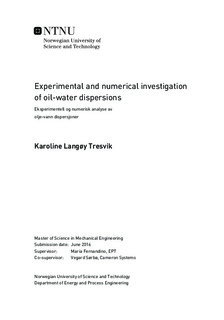Experimental and numerical investigation of oil-water dispersions - Eksperimentell og numerisk analyse av olje-vann dispersjoner
Master thesis
Permanent lenke
http://hdl.handle.net/11250/2412654Utgivelsesdato
2016Metadata
Vis full innførselSamlinger
Sammendrag
Crude oil in the reservoir is accompanied by formation water. Separating water fromoil offshore before transporting it is necessary. This requires compact and robust separators. In order to optimize the design of separators, a good understanding of separationmechanisms and crude oil behavior is essential. Testing separation with batch testscompared to continuous flow tests is less time assuming and less expensive. This workhas been dedicated to gain knowledge about batch settling, through experimental andnumerical investigation. Separation experiments with Exxsol D60, water and Span 80have been carried out. Testing with model oil instead of crude oil is beneficial. Theultimate goal is to simulate crude oil and water emulsions using a model fluid systems.Numerical simulations of mixing performance were performed as an optimization studybefore batch testing. They showed that both rotation and the presence of static bafflesimprove the mixing significantly. The experimental batch tests was performed with differentconcentrations of Span 80, different water cuts and different rotations. The resultshowed that Span 80 can be used as a surfactant to stabilize model oil. Investigationof what affects the stability the most was done. Rotation proved to have the greatesteffect. Span 80 concentrations of 0.05-0.2 vol.% showed small changes on the stability.It is suspected that these concentrations are too high, and that Span 80 should be estimatedwith respect to oil volume instead of total volume. Polderman s model was usedto connect batch data with flowing systems. Fluxes based on the batch result were plotted,and showed promising result which indicates that model oil can be used to simulatecrude oil. Experiments with the same fluid system were performed in a flowing rig. Thepurpose was to investigate if these tests provided the same stability result. This resultedin a stable emulsion, which prevented further flow tests. This may be because of a toohigh Span 80 concentration.
